Good audio should be accessible to everyone. While it’s very nice that I’m fortunate enough to be in the position to use the kind of gear that I never thought I would be able to have growing up, I recognize that more often than not, I’m yelling into the wind when I talk about how much I like stuff like the ZMF Atrium or Audeze LCD4. In the real world, the sub-$200 USD over ear open headphone market currently is dominated by two headphones: the planar-magnetic Hifiman HE400SE and the Sennheiser HD560S.
Testing Setups
I want to preface this review by listing the gear used in this review. It’s largely gear that is, by any reasonable standard, beyond overkill for these headphones, but theoretically that should give them the best shot at a recommendation. Whether or not that helps is answered below. I did try using my Scarlett 2i2 and Apple dongle to best simulate an average setup, and found that with these headphones, the experience was not significantly degraded compared to any of the below gear, so rest assured, you won’t need expensive gear for either of these headphones.
DAC | DDC | Amp |
Exogal Comet | Denafrips Gaia | Neurochrome DG300B |
Accurate Audio D1000 | Schiit Eitr | Questyle CMA800R |
Scarlett 2i2 |
| Firstwatt F5 |
Apple Lightning to 3.5mm |
| darTZeel NHB108 clone |
Headamp Pico (internal DAC) |
| Headamp Pico |
|
| Shortest Way 51+ |
HD560S
Ever since the HD560S was released, I’ve been curious to try it. It’s no secret that I’m a big fan of the HD580, HD600, and HD650, but I’ve also owned a few of Sennheiser’s lower end headphones and none of them have impressed. However, the HD560S actually measures well, so I had hope. Knowing myself though, I would use the HD560S for a couple minutes, think, “Neat,” then forget I had them. However, Den-Fi was gracious enough to send the HD560S and HE400SE out to me so I wouldn’t have to pay anything other than shipping, which goes down smoother than owning another headphone. At first listen, the HD560S surprised me, but in the wrong way.
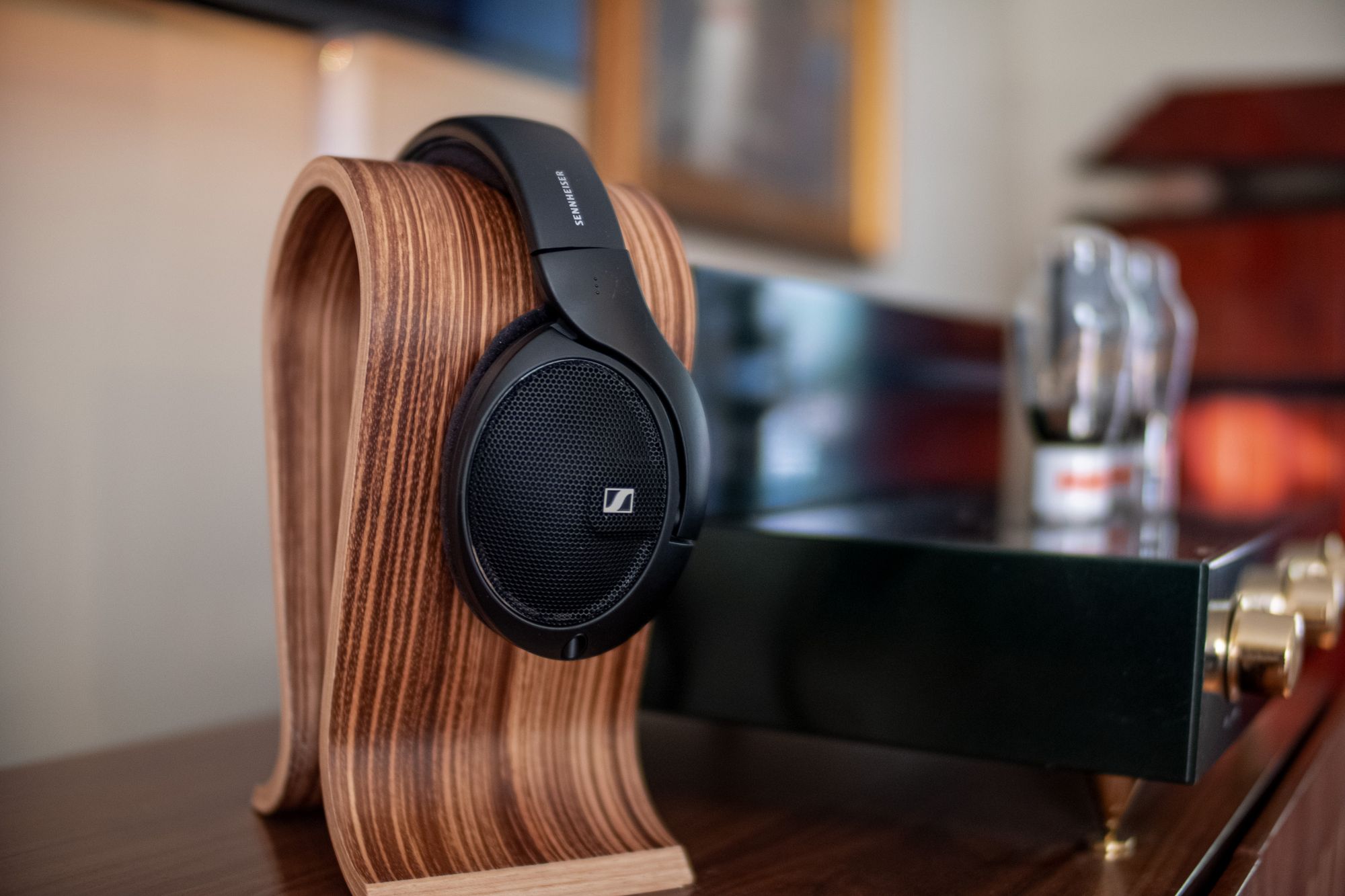
Bass
The HD560S was released at $200, which is close to the top of many first time buyer’s price range. For $200, I expected a bit more. The bass extension does surpass my HD580 and HD650, but it lacks definition in a way that reminds me of boosting sub-bass and mid-bass on my HD580 through EQ—it individual notes sound slightly blurred, which is disappointing because I thought Sennheiser may have finally figured out how to give good extension to a headphone with relatively minimal front volume seal and comfortable velour pads.
Midrange
While midrange is the main event with the HD6X0 series, it’s historically been less than stellar on the HD5X5, HD5X8, and HD5X9 series. Having owned an HD555, HD595, HD558, and HD598, they all dipped upper midrange just enough for them to give vocals a distant-sounding quality, and all sounded slightly nasal. In general I’ve always felt they sounded, “safe,” but in a way that is unengaging. The HD560S lifts upper midrange in the right direction, but still sounds thin in comparison to my HD580. This effect is compounded with a lack of mild low midrange boost the HD580 has which gives baritone and tenor voices body, and fullness to other instruments. The result is something that reminds me more of the Beyerdynamic DT880 than its older siblings.
Treble
Treble has been my biggest complaint with the previous generations of this headphone. They have all been incredibly grainy, which is a quality in a headphone’s treble that shows itself best in cymbals and harmonics. For those unfamiliar with grain, the easiest way I have been able to pick it out is to listen for cymbal decay. Cymbals should decay smoothly but in headphones where I hear grain, the decay sounds choppy, almost jagged. The HD595 was one of my first introductions to grainy treble, and the HD560S tames the grain, but not to the degree I would hope after all this time. Orchestral pieces still showcase the grain and if I focus on it, the HD560S’ treble does grate on me over time. However, it does sound brighter than the HD580 and HD650, so those fully averse to EQ and are willing to take the hit everywhere else may be interested in the HD560S. But honestly, just EQ. Even as someone that doesn’t EQ headphones that often, the HD560S falls short next to the HD580 and HD650 that it’s hard not to recommend trying to save up for the next step rather than taking an intermediate step that frankly sounds overpriced at MSRP.
Soundstage, Imaging, Dynamics, and Resolution
The HD560S has a respectably-sized headstage; it is larger than the HD580 and DT880, but soundstage isn’t something I index for in a headphone, as they all sound rather small to me. I am spoiled by having the ability to use speakers, but the idea of giving up anything in the frequency response to get a larger stage is lost on me, as the incremental expansion of stage sounds so small to me that it’s like throwing the baby out with the bath water. Imaging is on the positive side of average; at times instrument positioning is vague but I never found it to be muddy. Dynamics are a step up from the previous generation, but the lack of clarity in the low end and grain in the treble keep the HD560S from the impact of a truly dynamic headphone. Resolution and detail, I find, are nebulous terms that I rarely see defined by reviewers which always makes me hesitant to use them in reviews, but what stood out for me when going from the HD560S to any of my higher end headphones was a lack of texture. The harmonics of any song I listened to sounded smoothed out and less audible. The ringing decay of a steel string was lessened and instead, I mostly just heard the fundamental note. The echo in a room that I’ve heard in so many live recordings was cut short. I want to believe that this is what many people mean by, “detail,” but so many impressions I see simply seem to correlate to elevated treble or lack of dynamics. This shows most when I see people describe quiet sounds in a recording as “easier to hear.” A detailed headphone should not reduce dynamics and make the whispers in a jazz club easier to hear, it should allow for the listener to pick out discrete conversations and remove the vagueness between each person in the crowd, for example. The HD560S is an example of elevated treble making detail seem evident, but ultimately lacking in resolution of the actual recording. The treble boosts ambient sounds, making it easier to hear into the crowd while doing little to actually help discern what the crowd is saying.
Anyway, getting off my soapbox and onto the more interesting of the two headphones:

HE400SE
I’m very familiar with Hifiman. I’m somewhat ashamed to admit that I used to be somewhat of a Hifiman fanboy, as I have owned...most of what they released prior to the “eggfiman” series: HE-5, HE-5LE, HE-6, HE-500, HE-400i, HE-560 (both SMC and TRS jack versions) and finally, HE-1000V1. I’ve also had a good amount of time with the Susvara and Ananda (also some, but less time with the Arya V1, HE-1000V2 and SE, and XS), so please don’t think I have any negative biases when I say the following:
These sound pretty annoying.
Treble
I have been tolerant of Hifiman treble in the past but something about the HE400SE makes me wince. In songs I’ve heard countless times, I find myself bracing myself for cymbals, as they almost sound like distortion. I know what many may be thinking: “I bet they’re using it out of their laptop or something.” I wish that were the case, as I’d have some sort of plausible deniability as to why I don’t like it, but I’ve used the HE400SE out of several amps. I first used it out of my Questyle CMA800R as its current-mode topology tends to play nicely with planars but the first thing I noticed was a harshness to its treble that didn’t seem strictly FR-related. There’s a grit and grain to it that I’ve heard in other headphones in this price range like the Sennheiser HD598, but most don’t have that grain combined with a moderate treble elevation, so I’m smacked with treble grain. Cymbals’ decay sounds choppy, piccolo harmonics lack smoothness. This quality doesn’t usually change with different setups in my experience, but it was only fair to keep experimenting and trying to make the HE400SE sound nice with amps I could not imagine the average HE400SE owner would ever consider in the listed gear above. Unsurprisingly, nothing changed. While I have my reservations about the moderate amount of grain the HD560S has, the HE400SE’s treble is a step or two worse. For the price difference between the two, that’s not an absolute deal breaker, but even at $109, I find myself thinking I’d be unhappy with this treble for that amount of money.
And that’s just the treble!
Midrange
The HE400SE’s midrange between 1-2.5kHz is so recessed that I found myself wanting to turn the music up louder, only to be assaulted by the treble. This is a standard modern Hifiman trait that I personally don’t agree with, but I do understand that this recession does give Hifiman headphones a deep, almost spacious sound relative to most other headphones. This is a trick that other companies have implemented—for example, Sennheiser uses an upper midrange recession to make the HD800’s stage sound so large—when midrange is recessed, it appears to sound further away. The problem with what Hifiman does is that the relative recession straight into a relative accentuation of 3-4kHz makes vocals sound incredibly nasal, especially alto and soprano voices. The fundamental sounds recessed but the overtones are more audible with the 3-4k rise and it’s never sounded quite right to me. The HE400SE in particular seems to have a deeper recession than I recall from the XS, Arya, and Susvara so some vocals have an almost cavernous quality to them that makes vocal-focused music sound...not great. EQ does help with this, but the stage collapses in doing this and sounds not much bigger than the average IEM.
Bass
Most people I have encountered that are new to the hobby have this idea that planar magnetic headphones inherently have better bass than dynamics, likely because of certain YouTubers extolling the virtues of “planar bass” but in reality, many planar magnetic headphones are able to achieve flat extension to 20Hz because most of them have drivers that take up most of the front volume and have pad mounting mechanisms that allow for a good front volume seal. The “planar-ness” isn’t what causes the bass extension, and the HE400SE is a good example of this, as it doesn’t extend any better than the HD560S. In fact, most measurements comparing the two actually show that the HE400SE rolls off faster. It’s possible that all these people managed to put the HE400SE on their rigs incorrectly, but Hifiman headphones are historically tolerant of mild leakage so the most obvious explanation would be that extension is something the HE400SE lacks. Now, that’s not necessarily a deal breaker, as most music doesn’t actually need flat extension to 40Hz. Interestingly, the HE400SE sounds somewhat thicker in midbass than measurements show, which is a trait I haven’t found in other Hifiman headphones. While the idea of “planar bass” is typically perceived as flat extension, the commonality I’ve found with most planars is that they decay just a little too fast for kick drums and often lack the hard hitting transient I like hearing in them, so kick drums tend to sound like an over-stuffed. The HE400SE doesn’t suffer from this as much as other planars seem to, which may be related to the thickness I hear in the midbass. This isn’t measurable though, so I don’t want to make any concrete assertions but back to back versus my LCD-X and even the HD560S, it sounds surprisingly full, but is lacking in articulation.
Soundstage, Imaging, Dynamics, and Resolution
Soundstage, as mentioned above, is aided by the upper midrange recession. I don’t hear a great amount of width, but the recession does help with depth. Imaging is vaguer than the HD560S, but appropriate enough for the price point. I never truly miss placement of an instrument, so it passes minimum acceptability. Dynamics are something planar magnetics struggle with in my experience almost as a whole. The only two exceptions I’ve heard are the Hifiman HE-6 and Audeze LCD-4. I’ve heard the majority of planar magnetic headphones that have been released in the past decade, and the unifying factor in most of them is that they seem to give the illusion of sounding more detailed at first listen by compressing dynamics and making quiet sounds easier to hear. The HE400SE does not buck that trend. It’s lacking in dynamics but as a result, softer background sounds are easier to hear, But the messiness in the treble hurts the resolution I’ve defined above. There isn’t much texture to discern with the HE400SE, which is a shame.
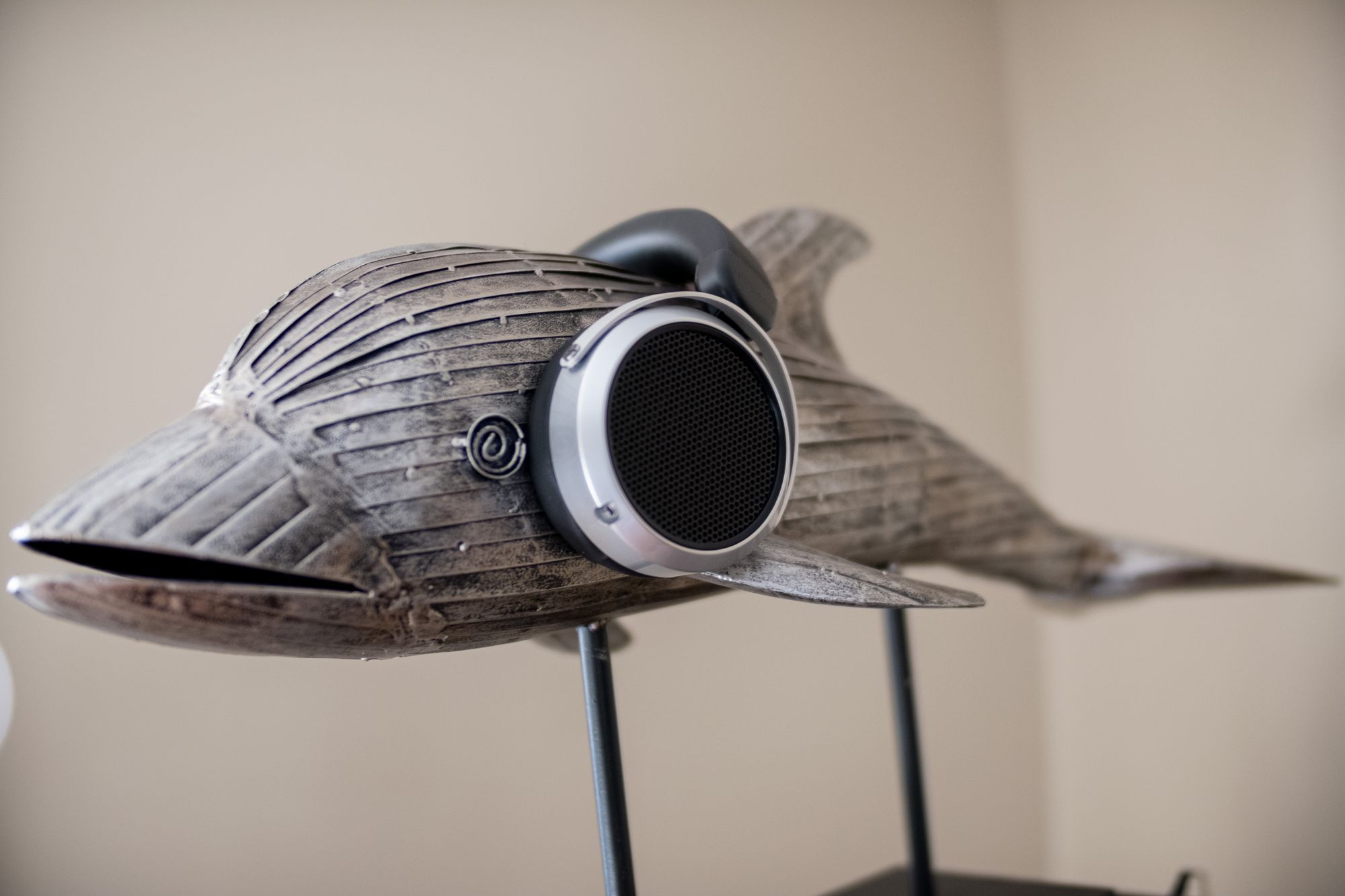
Now, this reads as super negative, contrasting with my first paragraph. It’s disappointing to dislike an affordable headphone so much. But in truth, there are so many other <$100 headphones that get the fundamentals more correct than the HE400SE. Hell, I found myself reaching for my Koss KSC75 more than a few times in this comparison as a sanity check and was disappointed to find that while the KSC75’s treble isn’t particularly clean, the HE400SE’s treble wasn’t much, if any cleaner. It also doesn’t suffer from the cave-y midrange the HE400SE has, though the HE400SE handily beats it in bass. I don’t understand the HE400SE; it’s a planar magnetic headphone, but doesn’t have the traits I typically appreciate from them, but it has almost all of the drawbacks.
"But what if I want to try a planar?"
Firstly, don’t treat planar magnetics as a monolithic unit any more than dynamic drivers; DCA headphones sound different from Audeze headphones sound different from Hifiman headphones sound different from T+A headphones sound different from Meze headphones...et cetera. They all have their relative house sounds and respective strengths and weaknesses.
Secondly, why spend $109 for a HE400SE when you can get a more normal-sounding vintage planar magnetic headphone for way less!

I may be dating myself by posting this, but in the late 00s and early 2010s, Wikiphonia was the website to learn about vintage headphones. It has since shuttered, but much of it is still accessible thanks to Wayback Machine.
The easiest recommendation I can give is to find as good of a condition Yamaha orthodynamic headphone as you can find. There are a several models, but the HP3, HP2, HP1 and the essentially identical YH3, YH2, and YH1 are excellent entries. Hilariously, the first time I heard the Meze Empyrean, my first thought was, “This is just a worse HP1.” and subsequent uses of the Empyrean have not changed that thought. They all sound excellent stock, but for those who find them a little too dark, simply buy a roll of Micropore medical tape (or any other kind of paper medical tape), gently peel the pads off to unscrew the baffle, and cover holes on the back of the driver with the tape. I would start with minimal coverage, as it can get bright quickly. I have sent my personal pair of HP3s to several people in the community and every single person who has tried it has been pleasantly surprised at how well the little things hold up. The most drastic response was a friend who sold his Susvara and bought two pairs of HP3s for me to mod for him and is perfectly content with the downgrade. Those more experienced with modding the Yamahas may wince at the idea of peeling the pads off, as this will likely lead to a loss of bass extension, but even after modding a dozen of these, I still struggle finding exactly where the screws are on the baffle. To bring the extension back, I deal with using adhesive to attach pads back onto the headphones. Double-sided tape often works, but I have had to use contact cement on some occasions.
There are a couple dozen other vintage planar magnetic headphones out there, and I’ve found very few duds, and certainly very few over which I actually prefer the HE400SE. In the picture are the Yamaha HP3, Yamaha HP2, Yamaha YH100, Akai ASE-800, Fostex T10, and Bang & Olufsen U70. The U70, unfortunately, is a miss, but the rest legitimately sound quite decent, and if I recall correctly, none of them cost more than $70, and I actually paid around $20 for the HP3. I wouldn’t recommend something unobtainable too; I have never seen an instance where I did not see a single vintage planar magnetic headphone on US eBay. I’m not familiar with the availablity outside of the US, but I know that Asia has plenty of vintage Fostex (the new T50RPs don’t even come close) and Europe has plenty of Peerless planar magnetic headphones. I am aware that many are wary of buying used, but I think the fears are overblown: while I can only speak for my own experiences, I personally have bought over 20 different vintage planar magnetic headphones over the course of the past decade and have never had an issue. Even if I did...historically, eBay does side with the buyer in most cases if a seller ships a faulty product.
Measurements
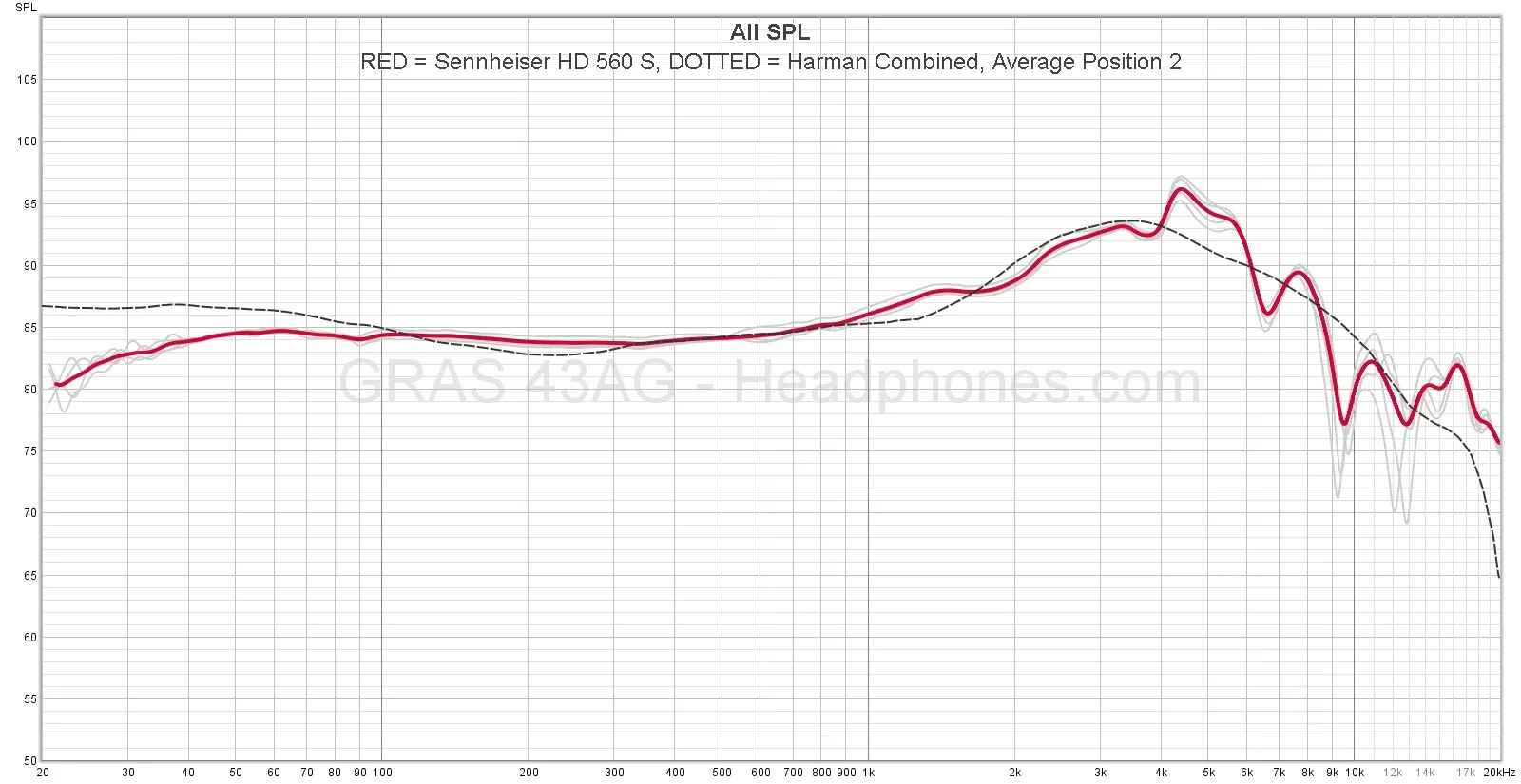
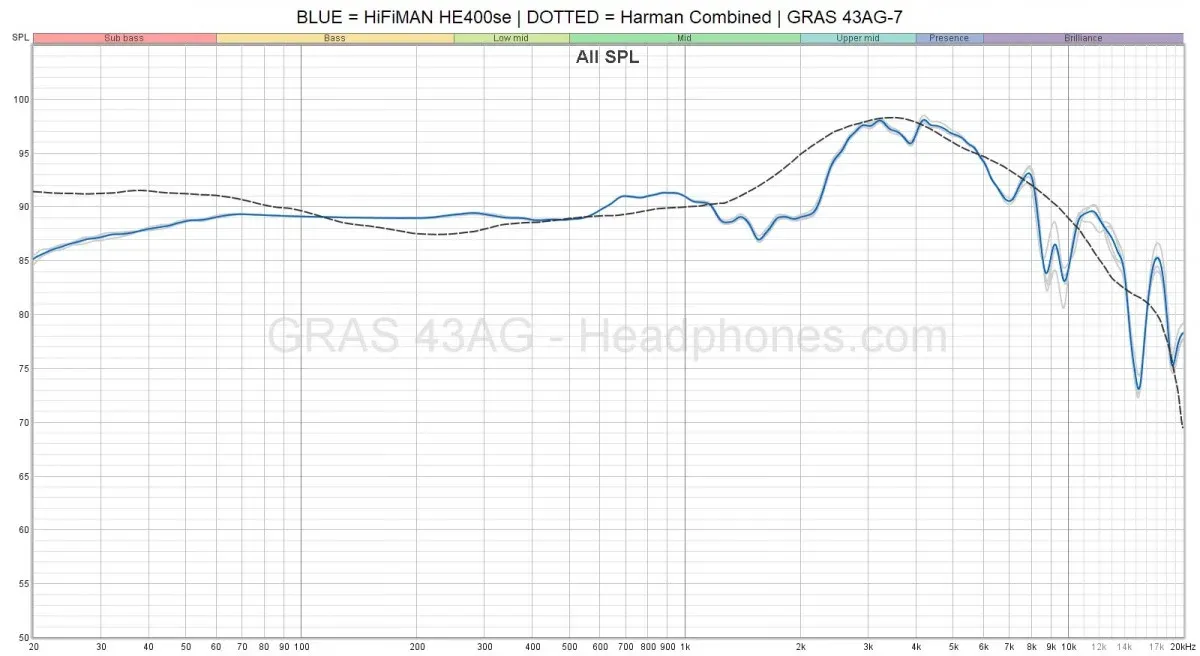
These two sets of measurements from headphones.com were taken about a year apart with the target curve placed about 5dB apart so it's hard glean exact differences between the two, but what I find most interesting is that despite the HE400SE measuring with less low-treble and mid-treble, I have no doubt that I perceive a little more treble as a while with the HE400SE. It likely is related to the grain I hear, and that the HE400SE measures with more upper treble, and an upper treble boost relative to dynamic headphones is a general trend I have experienced with planar magnetic headphones.
The "Hifiman dip" between around 1kHz into a rise at 3kHz shows itself in full force in the HE400SE's measurements, and the boost in center midrange likely contributes to the cave-like midrange I perceive with the HE400SE. Contrast that with the HD560S' upper midrange, which follows the target more closely and subjectively sounds less strange to me.
Also as mentioned above, both headphones have a bass roll off, but the HE400SE actually starts its roll off sooner. The HD560S starts rolling off at around 50Hz, while the HE400SE starts somewhere between 60Hz and 65Hz.
Crinacle measured two pairs of HD560S and interestingly, they seem to differ in bass extension but both do roll off less than the HE400SE:


To give one more data point, oratory1990 has also measured both headphones with similar results:
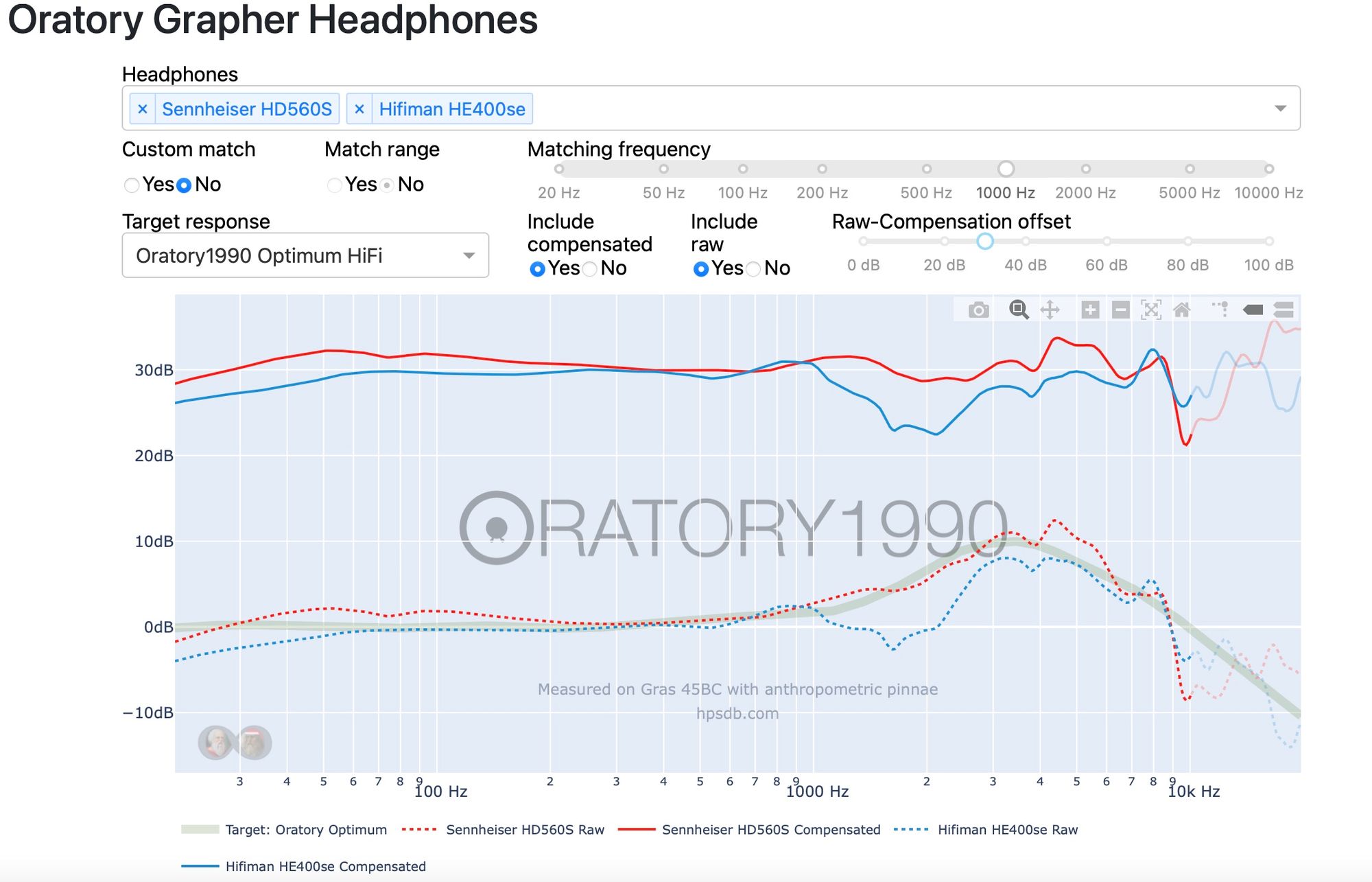
This is a more extreme difference, so, perhaps controversially, I will match to 1kHz:

Again, it is possible that all three measurements are wrong but since they historically tend to measure planar magnetic headphones with flat bass, they probably are not measuring the HE400SE incorrectly. Furthermore, I really do not hear flat extension with the HE400SE myself, which is never a problem I have with other modern planar magnetic headphones, so the most likely explanation is probably the correct one. Also, for those curious, the links to all these measurement tools are in the measurement images, so please support these amazing resources!
Conclusion
I’ve come away from this experience disappointed. While I think that the HD560S is fine in a vacuum, the MSRP leans on the high side for what you get. It’s not particularly clean, its dry sound may not work for many people more accustomed to bassier headphones, and the treble fatigued me. I have seen it on sale for cheaper, and have seen refurbished pairs on sale for under $100, which is a much more reasonable price for the HD560S.
The HE400SE was an even bigger disappointment. I know that it’s “only” $109, but I generally found it to actively annoy me in most cases, and that’s not something I experience even with a $15 Koss KSC75, or a $40 Creative Aurvana Live, or any of my cheap vintage headphones. Everyone deserves to hear good sound; by that virtue, I cannot recommend the HE400SE in good conscience.
Comments?
Leave us your opinion.